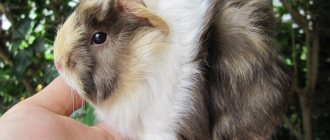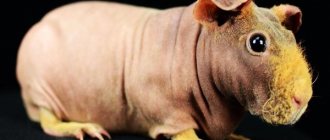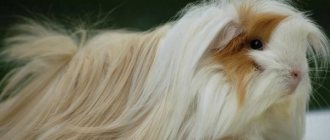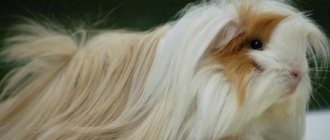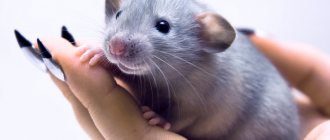Story
Guinea pigs are not related to pigs, and are not related to the aquatic environment. These are domesticated rodents from the pig family.
The domestication of these rodents occurred in the 5th millennium BC. e. In South America. The first people who began to use the meat of these animals for food were residents of tribes located in the territory of modern Peru, Ecuador, Bolivia and Colombia. In Peru and Ecuador, during excavations, statues of these rodents were found dating back to 500 BC. e to 500 AD e. In the Mochica tribe, the hairless guinea pig was considered a sacred animal. Selection carried out in the period from the 12th to the 15th centuries made it possible to develop various breeds of these animals. Some of those breeds became the basis for modern diversity. And later such a breed as the bald guinea pig appeared.
Hairless guinea pigs: history of the origin of breeds
The appearance of hairless breeds is caused by a gene mutation. A recessive gene found in hairless animals can be suppressed by a dominant gene. That is, in the event of a “meeting” of a mutating gene and a dominant one, the animal does not go bald, but is a carrier of this mutation. This mutated gene can affect the presence of hair in piglets in subsequent offspring.
Skinny Guinea Pig
The first hairless skinny guinea pig appeared by chance in a laboratory in Montreal. In this laboratory they were engaged in the selection of these rodents. In 1978, three females gave birth to babies from the same male, which were different from the usual newborn guinea pigs. They were completely bald. It was not possible to use these hairless cubs for further breeding. They were weak and soon died.
After 6 years, the incident with the birth of naked individuals was repeated. This time, the breeders managed to study the piglets and, with their help, develop a new breed. The founder of the breed was named Skinny. He gave the name to the whole breed.
The first naked pigs were all albino, that is, they had red eyes and white skin. But as a result of crossing, it was possible to obtain animals with different skin colors.
Baldwin Guinea Pig
The Baldwin breed was created in the same unusual way. 10 years later, American breeder Carol Miller gave birth to cubs during crossing. The cubs were born with fur, but by the end of the first seven days the pig had shed all its fur. The owner was afraid that the pets were sick, but they were active, growing, like their “hairy” peers, and an examination by a veterinarian revealed no signs of illness. Afterwards, the breeder again crossed the parents of the bald pigs and got the same result. So she developed a new breed of Baldwin guinea pig.
Reproduction
There is no need to create special conditions for reproduction; everything is simple and easy. Females reach sexual maturity at the age of 2-2.5 months, males at 3 months. But here it is worth saying that at this age the body is not fully formed, it is quite weak, and the immune system is also not strengthened, so pregnancy at this age is not desirable, even dangerous. The optimal age at which mating is recommended is 6 months.
During pregnancy, vitamin E, B and others must be added to the diet to ensure the health of the mother and cubs. Nutrition should be correct and complete, but make sure there is no overfeeding. The duration of pregnancy is about 70 days.
During this time she needs separate housing. Try to protect her from stress as much as possible and touch her less. Handle only in extreme cases, do not squeeze, so as not to harm the fetus.
After giving birth, the female needs at least six months to fully recover, after which she can be bred again. At 6–8 months, the female is ready to continue the race. Males become sexually mature starting at three months. However, the optimal age for producing offspring is six months for females and 7 months for males.
Appearance of naked guinea pigs
Externally, hairless rodents are similar, but both breeds also have distinctive features.
What does Skinny pig look like?
Skinny individuals are from 30 to 35 centimeters in length and weigh up to a kilogram. Skinny pigs have a large body and short legs. Females are smaller than males. The large head has large round ears. The eyes are round and can be red, black or chocolate.
Skin color can be single, two or three colors. There is a short fuzz on the skin that creates a soft feeling when touched. There is short hair on the animal's face and paws.
What does a Baldwin pig look like?
These animals look more modest than Skinny. Their length is from 20 to 25 cm, weight up to 800 g. A distinctive feature of this breed is the hump on its nose. The head is large with a rather graceful build. Ears are drooping. The eyes are red or black, round in shape. Absolutely bald skin is not as soft as that of skinny’s relatives. A distinctive feature of the breed is the folds on the paws, neck and back. Color from dark to beige.
Texels
Texel is one of the most beautiful breeds, known since the mid-80s of the last century. Texels are distinguished by long, thick fur that breaks up into clearly defined curls, a long train and fluffy sideburns. The length of the coat is 12-18 cm. The rounded muzzle is decorated with large expressive eyes. Texels are calm, friendly and sociable.
Looking at the photo of a Texel guinea pig, it seems that caring for such luxurious fur requires special effort. In reality, they do not require daily brushing, and it does not take much time to select hay and sawdust from their fur. Animals that do not take part in exhibitions usually have their fur shortened.
Merino
The curly coat grows in the same way as the Texel, only there is a rosette on the head.
Agouti
Agoutis are the ancestors of all modern breeds. Each animal's hair has different shades at the base and at the end.
Roans
The head, paws, ears are painted in the main color without any admixture of another shade, only on the body there is a so-called salt and pepper mixture, when hairs of one color are mixed with hairs of another color.
Teddy
Teddies are similar to Rex cats, but their fur is slightly shorter and softer. Thick, dense and elastic, straight (or slightly wavy), the hair stands on end all over the pig's body, and feels like plush. Pictured is a Gold and White American Teddy
Rex
The main difference between Rex guinea pigs is their hard, dense, slightly curly fur, about 1.7 cm long. The hairs stand on end, which creates a plush effect. Color options can be any.
Ridgeback
It is a smooth-haired pig, but there is a difference - there is a rosette on the rump, and on the back the hair is collected into a kind of comb of standing vertical hair.
Cresteds
Smooth-haired pigs with a rosette on the crown. There are English and American Cresteds. In American cats, the color of the rosette should contrast with the color of the main color; in English cats, it should be identical to it.
Satin guinea pigs
A distinctive feature of the satin pig group is its surprisingly soft, silky coat with a glossy effect. The wool shines and shimmers due to the special hollow structure of the hairs. The Satin coat type is found in all short-haired and long-haired breeds. The rarest animals are golden, lilac and buffalo in color.
Character and behavior of hairless animals
Breeders of hairless pets describe them as affectionate, gentle and sociable pets. They are calm with other pets such as hamsters, cats, and miniature dogs.
Communication is an important factor for hairless pigs. They love to sit on your hands when petted, and purr touchingly.
Like all small rodents, representatives of the Skinny and Baldwin breeds are shy. They don't like loud noises. You cannot shout at them or use violent actions. They subtly sense rude attitudes. Against the backdrop of a tense situation, they may become depressed.
Animals perceive the volume of sounds more sensitively than people. Therefore, even a loud TV creates an anxious state for the animal.
The intelligence of Skinny and Baldwin is developed. They remember their owners and greet them joyfully. They are also able to remember their name and respond to it. Representatives of these pig breeds are also trainable. They can be taught to come on command, push the ball towards the owner and spin around themselves.
The appearance and close attention of strangers creates a tense state in the pig. Therefore, you should not allow people who are strangers to your pet to immediately pick up the animal. First, it is necessary for the animal to get used to the new person.
How to choose a skinny and how much the animal costs
It’s worth mentioning right away that this breed is not cheap, they are quite rare animals, and therefore their cost is higher. For one individual, breeders set prices from 19 to 38 dollars.
If you decide to purchase just such a breed, then spend a little time finding a reliable and trusted nursery, this way you will protect yourself from buying an unhealthy rodent.
When we purchase furry animals, the condition of the fur can tell us about its health. In a healthy rodent it is shiny, smooth, without any bald spots. But in the case of buying a skinny, we cannot rely on these criteria, so we need to pay attention to other signs that indicate good health:
- The guinea pig should be active and mobile.
- There should be no discharge on the eyes.
- There should be no nasal discharge.
- Paws are clean and dry.
- Moderately well-fed.
- The skin should be smooth and clean, without any damage or inflammation.
- The area near the anus should be clean.
Remember that despite her friendliness and love for attention and affection from a person, she needs rest. Therefore, you do not need to constantly hold her in your arms, give her time to rest so that she can rest and not suffer from excessive attention.
Care and maintenance at home
Caring for hairless pets involves all the same procedures as keeping a guinea pig of fluffy breeds. Only the lack of fur makes its own adjustments. Skinny and Baldwin skin is more sensitive, as it is exposed to direct environmental influences. Therefore, it is necessary to take this factor into account when providing your pet with everything it needs at home.
Housing
For furry representatives, it is recommended to purchase cages and enclosures. A terrarium is more suitable for hairless breeds. Since pets do not have fur to keep them warm and retain heat, it is easier for them to catch a cold. The cells allow air to pass freely, which creates drafts. The blank walls of the terrarium protect animals from drafts. In the cold season, it would be useful to install a heating lamp.
Sawdust bedding is not suitable for hairless animals. Their skin can be damaged and irritated by the sharp edges of the wood, as well as by the moisture that is absorbed into the filler. Soft hay or diapers are more suitable for these animals. But fabric bedding needs to be changed frequently, which is a certain inconvenience.
Nutrition
The diet of hairless pigs is no different from the diet of furry representatives of the pig family. But the latter have wool that retains body heat. The hairless representatives of these animals do not have hair, so they need additional energy to maintain them. They get this energy from food. The metabolism in the body of representatives of hairless breeds is faster than that of their furry relatives, so they need to be fed more often. Fresh hay and water should always be present in the cage.
Water treatments
Bathing for hairless animals is not necessary, and using shampoos is even contraindicated. The skin of these animals produces a special secretion that moisturizes the skin and protects it from dryness and cracking. Water procedures wash away this protective film, as a result of which the pet’s skin is left without protection. Therefore, it is recommended to only wipe the pet with a damp cloth or napkin.
Distinctive features of hairless breeds
Hairless sea pets have some characteristics that you should know about before purchasing such pets.
Pets' sensitive skin is susceptible to exposure to sunlight. This means that the pet’s home cannot be placed on the sunny side, otherwise the pet may get burned.
The temperature in the room where the hairless animal is kept should be maintained at 22 degrees. The normal body temperature of an animal is 38–39 degrees.
Feeding these rodents must be more frequent due to their accelerated metabolism. Therefore, keeping a hairless guinea pig is more expensive.
Some people are allergic to wool and do not have pets. The exception is hairless animals.
The life expectancy of representatives of hairless breeds is longer, it ranges from 5 to 9 years.
Cost of hairless guinea pigs
Representatives of the Skinny and Baldwin breeds are exotic rodents. Therefore, their cost is higher than that of woolly breeds. A hairless guinea pig costs from 4 to 9 thousand rubles. The price for a two or three color pig will be even higher.
The appearance of the hairless animals resembles a miniature hippopotamus, which partly explains its increased price.
Owner reviews
Reviews from breeders agree that hairless rodents are sociable animals. They take up little space and do not require additional walks. For allergy sufferers, these animals are a real find, as they are hypoallergenic. The owners also say that these animals have a gentle disposition and friendly relations with other pets. On the Internet you can find photographs of your pet sleeping with a cat.
Breeders of pigs are very gluttonous, but at the same time unpretentious in food. For example, social media star Ludwig. His food photos are popular in the guinea pig community.
Before getting any animal, you need to study information about its behavior, care, feeding and maintenance. Hairless rodents are friendly and sociable, which will undoubtedly please their owners. But we must not forget about the features of caring for these cute animals.
Feeding rules
It was already mentioned above about increased metabolism and more abundant feeding. But still, you shouldn’t go to extremes - overfeeding will definitely lead to obesity.
According to feeding standards, the diet of small “sphinxes” should have the following proportions:
- 60% - grass in summer or forb hay in winter;
- 20% - root and tuber crops and other vegetables;
- 20% - grain feed (oats, peas, barley, etc.).
Instead of the grain component, you can use ready-made balanced super-premium or premium food.
Additionally, pets are given vitamins, feed additives with macro- and microelements, a little regular salt and chalk. In addition, do not forget about adding ascorbic acid to the water; it is especially important to fulfill this condition in winter, when there is little green food in the diet - natural sources of vitamin C.
It is always worth remembering to drink water. It must always be fresh, clean and freely available. Change it twice a day (or more often).
A branch of a fruit tree should always be present in the terrarium. Pets grind their sharp teeth on it.
Important!
- Guinea pigs should not be fed garlic, radishes, nightshades or mushrooms!
- You should not go on a hunger strike: lack of food for two days will certainly lead to the inevitable death of your pet!
